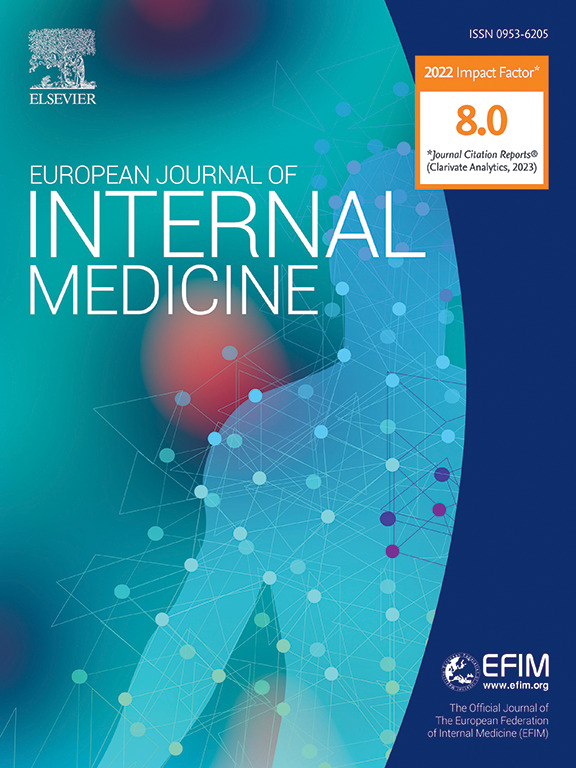免疫力低下的重症监护室患者的腹腔内感染和败血症:疾病表现、微生物病因和临床结果。
IF 5.9
2区 医学
Q1 MEDICINE, GENERAL & INTERNAL
引用次数: 0
摘要
我们比较了免疫力低下和非免疫力低下重症监护病房患者腹腔内感染(IAI)的流行病学,并确定了死亡率的风险因素。我们对 "AbSeS "数据库进行了二次分析,该数据库是一项前瞻性观察研究,收录了来自 42 个国家 309 个 ICU 的 IAI 患者。免疫力低下的定义为中性粒细胞减少或长期使用皮质类固醇、过去一年接受过化疗或放疗、骨髓或实体器官移植、先天性免疫缺陷或使用免疫抑制剂。死亡率定义为重症监护室任何时间的死亡率或提前出院者的 28 天死亡率。死亡率的相关性通过逻辑回归进行评估。队列中包括 2589 名患者,其中 239 名免疫功能低下患者(9.2%),大部分患者患有继发性腹膜炎。与免疫功能正常的患者相比,免疫功能低下的患者中胆道感染的发生率较低,斑疹伤寒的发生率较高,而IAI则更多地由医护人员引起或早期在医院获得。在解剖结构破坏等级、疾病严重程度、器官衰竭、病原体和抗药性模式方面不存在差异。脓毒性休克在免疫力低下的人群中发病率明显更高。两组患者的死亡率相似(31.1% 对 28.9%;P = 0.468)。免疫力低下不是死亡率的风险因素(OR 0.98,95 % CI 0.66-1.43)。免疫力低下患者死亡的独立风险因素包括:发病时出现脓毒性休克(OR 6.64,95 % CI 1.27-55.72),以及炎症持续存在时病源控制不成功(OR 5.48,95 % CI 2.29-12.57)。在患有IAI的免疫功能低下重症监护病房患者中,短期死亡率与免疫功能正常患者相似,尽管前者更常出现脓毒性休克,而且脓毒性休克和病源控制后的持续炎症是导致死亡的独立风险因素。本文章由计算机程序翻译,如有差异,请以英文原文为准。
Intra-abdominal infection and sepsis in immunocompromised intensive care unit patients: Disease expression, microbial aetiology, and clinical outcomes
We compared epidemiology of intra-abdominal infection (IAI) between immunocompromised and non-immunocompromised ICU patients and identified risk factors for mortality.
We performed a secondary analysis on the “AbSeS” database, a prospective, observational study with IAI patients from 309 ICUs in 42 countries. Immunocompromised status was defined as either neutropenia or prolonged corticosteroids use, chemotherapy or radiotherapy in the past year, bone marrow or solid organ transplantation, congenital immunodeficiency, or immunosuppressive drugs use. Mortality was defined as ICU mortality at any time or 28-day mortality for those discharged earlier. Associations with mortality were assessed by logistic regression.
The cohort included 2589 patients of which 239 immunocompromised (9.2 %), most with secondary peritonitis. Among immunocompromised patients, biliary tract infections were less frequent, typhlitis more frequent, and IAIs were more frequently healthcare-associated or early-onset hospital-acquired compared with immunocompetent patients. No difference existed in grade of anatomical disruption, disease severity, organ failure, pathogens, and resistance patterns. Septic shock was significantly more frequent in the immunocompromised population. Mortality was similar in both groups (31.1% vs. 28.9 %; p = 0.468). Immunocompromise was not a risk factor for mortality (OR 0.98, 95 % CI 0.66–1.43). Independent risk factors for mortality among immunocompromised patients included septic shock at presentation (OR 6.64, 95 % CI 1.27–55.72), and unsuccessful source control with persistent inflammation (OR 5.48, 95 % CI 2.29–12.57). In immunocompromised ICU patients with IAI, short-term mortality was similar to immunocompetent patients, despite the former presented more frequently with septic shock, and septic shock and persistent inflammation after source control were independent risk factors for death.
求助全文
通过发布文献求助,成功后即可免费获取论文全文。
去求助
来源期刊
CiteScore
9.60
自引率
6.20%
发文量
364
审稿时长
20 days
期刊介绍:
The European Journal of Internal Medicine serves as the official journal of the European Federation of Internal Medicine and is the primary scientific reference for European academic and non-academic internists. It is dedicated to advancing science and practice in internal medicine across Europe. The journal publishes original articles, editorials, reviews, internal medicine flashcards, and other relevant information in the field. Both translational medicine and clinical studies are emphasized. EJIM aspires to be a leading platform for excellent clinical studies, with a focus on enhancing the quality of healthcare in European hospitals.

 求助内容:
求助内容: 应助结果提醒方式:
应助结果提醒方式:


